
Concept explainers
Draw a structure corresponding to each name.
a.
b.
c.
d.
e.
f.
(a)
Interpretation: The structure which corresponds to the IUPAC name of the given compound is to be stated.
Concept introduction: IUPAC nomenclature is a systematic way of naming the organic compounds. The basic principles of IUPAC naming for benzene derivatives are:
1. The compound consists of benzene ring is named as substituent followed by benzene.
2. When the ring is mono-substituted, then there is no need of numbering.
3. When the ring is substituted with same substituents, then numbering to one substituent is given and for other substituent, numbering proceed from clockwise or anticlockwise such that it gets lower number.
4. When the ring is substituted with different substituents, then the numbering is done according to the priority.
5. Substituents on benzene ring is also indicated using ortho, meta, para prefix. The prefix ortho is used when substituents are on adjacent carbon, meta is used when substituents are separated by one carbon atom, para is used when substituents are across each other in benzene ring.
Answer to Problem 17.28P
The structure of the given compound is,
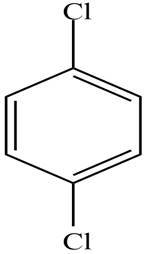
Explanation of Solution
The IUPAC name of the compound is
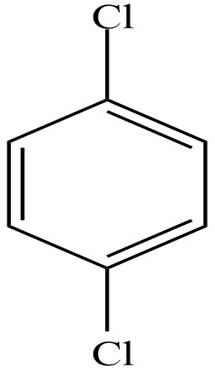
Figure 1
The structure of the given compound is shown in Figure 1.
(b)
Interpretation: The structure which corresponds to the IUPAC name of the given compound is to be stated.
Concept introduction: IUPAC nomenclature is a systematic way of naming the organic compounds. The basic principles of IUPAC naming for benzene derivatives are:
1. The compound consists of benzene ring is named as substituent followed by benzene.
2. When the ring is mono-substituted, then there is no need of numbering.
3. When the ring is substituted with same substituents, then numbering to one substituent is given and for other substituent, numbering proceed from clockwise or anticlockwise such that it gets lower number.
4. When the ring is substituted with different substituents, then the numbering is done according to the priority.
5. Substituents on benzene ring is also indicated using ortho, meta, para prefix. The prefix ortho is used when substituents are on adjacent carbon, meta is used when substituents are separated by one carbon atom, para is used when substituents are across each other in benzene ring.
Answer to Problem 17.28P
The structure of the given compound is,
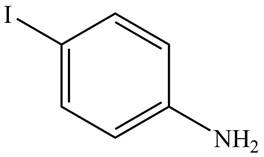
Explanation of Solution
The IUPAC name of the given compound is
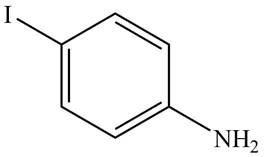
Figure 2
The structure of the given compound is shown in Figure 2.
(c)
Interpretation: The structure which corresponds to the IUPAC name of the given compound is to be stated.
Concept introduction: IUPAC nomenclature is a systematic way of naming the organic compounds. The basic principles of IUPAC naming for benzene derivatives are:
1. The compound consists of benzene ring is named as substituent followed by benzene.
2. When the ring is mono-substituted, then there is no need of numbering.
3. When the ring is substituted with same substituents, then numbering to one substituent is given and for other substituent, numbering proceed from clockwise or anticlockwise such that it gets lower number.
4. When the ring is substituted with different substituents, then the numbering is done according to the priority.
5. Substituents on benzene ring is also indicated using ortho, meta, para prefix. The prefix ortho is used when substituents are on adjacent carbon, meta is used when substituents are separated by one carbon atom, para is used when substituents are across each other in benzene ring.
Answer to Problem 17.28P
The structure of the given compound is,
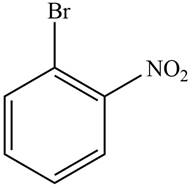
Explanation of Solution
The IUPAC name of the compound is

Figure 3
The structure of the given compound is shown in Figure 3.
(d)
Interpretation: The structure which corresponds to the IUPAC name of the given compound is to be stated.
Concept introduction: IUPAC nomenclature is a systematic way of naming the organic compounds. The basic principles of IUPAC naming for benzene derivatives are:
1. The compound consists of benzene ring is named as substituent followed by benzene.
2. When the ring is mono-substituted, then there is no need of numbering.
3. When the ring is substituted with same substituents, then numbering to one substituent is given and for other substituent, numbering proceed from clockwise or anticlockwise such that it gets lower number.
4. When the ring is substituted with different substituents, then the numbering is done according to the priority.
5. Substituents on benzene ring is also indicated using ortho, meta, para prefix. The prefix ortho is used when substituents are on adjacent carbon, meta is used when substituents are separated by one carbon atom, para is used when substituents are across each other in benzene ring.
Answer to Problem 17.28P
The structure of the given compound is,
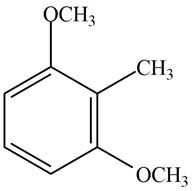
Explanation of Solution
The IUPAC name of the compound is
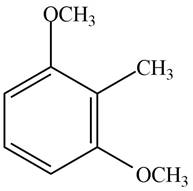
Figure 4
The structure of the given compound is shown in Figure 4.
(e)
Interpretation: The structure which corresponds to the IUPAC name of the given compound is to be stated.
Concept introduction: IUPAC nomenclature is a systematic way of naming the organic compounds. The basic principles of IUPAC naming for hydrocarbon are:
1. The hydrocarbon is named after the carbon chain containing higher number of carbon atoms.
2. Alkenes are named after their parent hydrocarbon chain with suffix ‘ene’.
3. For functional group such as alcohol suffix ‘ol’ is added to the name.
4. When the ring is substituted with different substituents, then the numbering is done according to the priority.
Answer to Problem 17.28P
The structure of the given compound is,
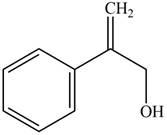
Explanation of Solution
The IUPAC name of the compound is
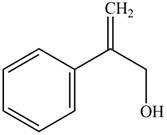
Figure 5
The structure of the given compound is shown in Figure 5.
(f)
Interpretation: The structure which corresponds to the IUPAC name of the given compound is to be stated.
Concept introduction: IUPAC nomenclature is a systematic way of naming the organic compounds. The basic principles of IUPAC naming for a cycloalkane are:
1. The cycloalkane is named after its parent hydrocarbon chain with a prefix cyclo.
2. When the ring is mono-substituted then there is no need of numbering.
3. When the ring is substituted with same substituents then numbering to one substituent is given and for other substituent numbering proceed from clockwise or anticlockwise such that it gets lower number.
4. When the ring is substituted with different substituents, then the numbering is done according to the priority.
5. When alkyl chain has more carbon atoms than the cycloalkane then, the substituent is named as cycloalkyl group.
Answer to Problem 17.28P
The structure of the given compound is,
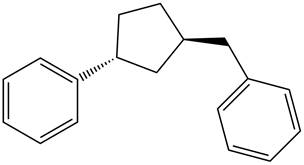
Explanation of Solution
The IUPAC name of the compound is

Figure 6
The structure of the given compound is shown in Figure 6.
Want to see more full solutions like this?
Chapter 17 Solutions
Organic Chemistry
- Draw the organic product(s) formed when CH3CH2CH2OH is treated with each reagent. a.H2SO4 b.NaH c.HCl + ZnCl2 d.HBr e.SOCl2, pyridine f.PBr3 g.TsCl, pyridine h. [1] NaH; [2] CH3CH2Br [1] i.TsCl, pyridine; [2] NaSH j.POCl3, pyridinearrow_forwardWhich is the major organic product of this reaction? A. B. 4 ОА O OB O C COD AICI3 benzene C. D.arrow_forwardNitration of chlorobenzene gives A. o - chloronitrobenzene B. p - chloronitrobenzene C. m – chloronitrobenzene D. A and B BO DO CO A Oarrow_forward
- Give the structure corresponding to each name. a. 5,6-dimethylhept-2-yne b. 5-tert-butyl-6,6-dimethylnon-3-yne c. (S)-4-chloropent-2-yne d. cis-1-ethynyl-2-methylcyclopentane e. 3,4-dimethylocta-1,5-diyne f. (Z)-6-methyloct-6-en-1-ynearrow_forwardDraw the products formed when p-methylaniline (p-CH3C6H4NH2) is treated with each reagent. a. HCl b. CH3COCl c. (CH3CO)2O d. excess CH3I e. (CH3)2C = O f. CH3COCl, AlCl3 g. CH3CO2H h. NaNO2, HCl i. Part (b), then CH3COCl, AlCl j. CH3CHO, NaBH3CNarrow_forwardBr KOH / DMSO 6. b. 2-methyl-1-propanol d. 1,2- a. 2-methylpropene propanediene c. no reaction e. something else! 7. cyclopentanol + NaH + DMSO+ bromopropane à(major product) a. cyclopentene reaction b. propene c. propyl cyclopentyl ether d. no e. something else!! 8. 2-bromo-3-methylbutane + KOH / DMSO à(major product) a. 2-methyl-1-butene d. no reaction b. 2-methyl-2-butene c. 3-methyl-2-butanol e. something else!! 9. 2-chloro-3-methylbutane + KI / DMSO à(major product) a. 2-methyl-1-butene b. 2-methyl-2-butene c. 3-methyl-2-iodobutane d. no rxn e. something else!! 10. (S)-2-iodobutane + NaN; / DMF à (major product) N3 c. f. something else!! а. b. с. d. е. no rxn 11. cyclohexene + NBS/ CCl, / light followed by K* t-butoxide / t-butanol with heating à a. cyclohexene b. 1,3-cyclohexadiene cyclohexane e. something else! c. 1,2-cyclohexadiene d.arrow_forward
- What is the major organic product obtained from the following reaction? A. CI B. H 1. (CH3CH₂)2CuLi 2. H3O+ C. D. •ay.a OHarrow_forwardcis-Cyclohexane-1,2-diol can be synthesized from cyclohexene by using which reagent? a.O3 b.OsO4 c.H2SO4 d.mCPBAarrow_forwardDraw the organic products formed when cyclopentene is treated with each reagent. With some reagents, no reaction occurs. a.H2 + Pd-C b.H2 + Lindlar catalyst c.Na, NH3 d.CH3CO3H e.[1] CH3CO3H; [2] H2O, HO− f.[1]OsO4 + NMO; [2] NaHSO3, H2O g.KMnO4, H2O, HO− h.[1] LiAlH4; [2] H2O i. [1] O3; [2] CH3SCH3 j.(CH3)3COOH, Ti[OCH(CH3)2]4, (−)-DET k.mCPBA l.Product in (k); then [1] LiAlH4; [2] H2Oarrow_forward
- 64. Which of the following reactant-product relationship is correct? A. 2-methylbutan-2-ol 2-methylbutanoic acid KMnO4 B. 2-methylbutan-2-ol 2-methylbut-3-ene H2504 C. 4-tert-butylcyclohexanol 4- tertbutylcyclohexanone Na2Cr207 D. 4- tertbutylcyclohexanol 4- tertbutylcyclohexanone 7 H2504 65. Choose the correct steps in the dehydration of secondary alcohol; then, arrange in chronological order. 1- Formation of Alkene Il-Formation of Aldehyde III- Formation of Protonated alcohol IV-Undergoes E2 mechanism V-Undergoes E1 mechanism A. V-III-I B. IV-III-II C. III-V-I D. III-IV-II 66. ALL of the following Ether can be prepared by Williamson's method, EXCEPT: A. Ditert-butyl ether B. Ethyl-tert-butyl ether C. anisole D. Both A & B 67. Ethanol is heated with an acidified potassium manganate (VII) solution. What would be the product of this reaction? A. Ethanal B. Ethene C. Ethanoic acid D. Ethanearrow_forwardDraw the organic product(s) formed when CH3CH₂CH₂OH is treated with each reagent. a. H₂SO4 d. HBr g. TsCl, pyridine b. NaH h. [1] NaH; [2] CH₂CH₂Br e. SOCI₂, pyridine f. PBr3 c. HCI + ZnCl₂ Hint: NaH deprotonates the alcohol forming an alkoxidearrow_forwardGive the structure corresponding to each name. a. butyl ethyl ketone c. p-ethylacetophenone b. 2-methyl-3-pentanone d. 2-propylcyclobutanonearrow_forward
 ChemistryChemistryISBN:9781305957404Author:Steven S. Zumdahl, Susan A. Zumdahl, Donald J. DeCostePublisher:Cengage Learning
ChemistryChemistryISBN:9781305957404Author:Steven S. Zumdahl, Susan A. Zumdahl, Donald J. DeCostePublisher:Cengage Learning ChemistryChemistryISBN:9781259911156Author:Raymond Chang Dr., Jason Overby ProfessorPublisher:McGraw-Hill Education
ChemistryChemistryISBN:9781259911156Author:Raymond Chang Dr., Jason Overby ProfessorPublisher:McGraw-Hill Education Principles of Instrumental AnalysisChemistryISBN:9781305577213Author:Douglas A. Skoog, F. James Holler, Stanley R. CrouchPublisher:Cengage Learning
Principles of Instrumental AnalysisChemistryISBN:9781305577213Author:Douglas A. Skoog, F. James Holler, Stanley R. CrouchPublisher:Cengage Learning Organic ChemistryChemistryISBN:9780078021558Author:Janice Gorzynski Smith Dr.Publisher:McGraw-Hill Education
Organic ChemistryChemistryISBN:9780078021558Author:Janice Gorzynski Smith Dr.Publisher:McGraw-Hill Education Chemistry: Principles and ReactionsChemistryISBN:9781305079373Author:William L. Masterton, Cecile N. HurleyPublisher:Cengage Learning
Chemistry: Principles and ReactionsChemistryISBN:9781305079373Author:William L. Masterton, Cecile N. HurleyPublisher:Cengage Learning Elementary Principles of Chemical Processes, Bind...ChemistryISBN:9781118431221Author:Richard M. Felder, Ronald W. Rousseau, Lisa G. BullardPublisher:WILEY
Elementary Principles of Chemical Processes, Bind...ChemistryISBN:9781118431221Author:Richard M. Felder, Ronald W. Rousseau, Lisa G. BullardPublisher:WILEY





